Sultans’ dreams: The Ottomans’ unfulfilled Istanbul projects
Saro DADYAN – Istanbul Life
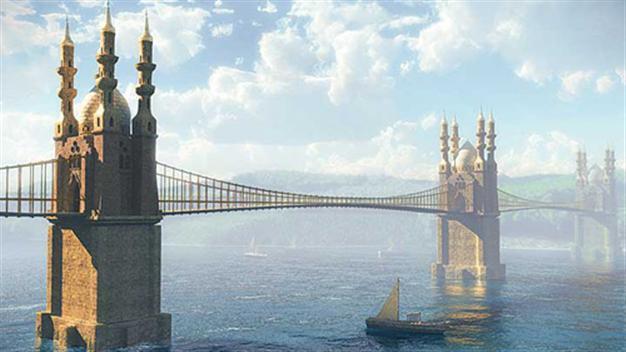
A modern illustration of the 19th century project to link Europe and Asia with a railroad bridge on the Bosphorus.
A gigantic monument that Sultan Abdülmecid wanted to build to commemorate the Crimean War…Sarkis Balyan’s project to build a bridge between the Heybeliada and Büyükada islands…
Osman Hamdi’s project to build a funicular between Taksim and Kabataş…
All these were among the projects that could not be fulfilled in 19th century Ottoman Istanbul, for various reasons.
“The last quarter of the [19th] century is an incredible period filled with countless unrealized projects,” says architectural historian Doğan Kuban. “Although they may seem like utopias coloring the sultans’ dreams, realizing some of those projects was actually easier at the time. Had these projects been realized, we can imagine Istanbul as a spectacular metropolis with a subway system as old as the ones in big cities around the world, monumental bridges, palaces, barracks and train stations.”
Had these projects come to fruition, what kind of Istanbul would we be living in right now?
1) THE FIRST CITY PLAN BY VON MOLTKE
A plan to reorganize the entire city of Istanbul was first mapped out by German military commander Helmuth von Moltke in 1839. Von Moltke, commissioned by Sultan Mahmut II to draw a map of Istanbul and organize the streets, determined the city’s most important problems and mapped out a plan to address them.
For Von Moltke, the biggest problem was transportation within Istanbul’s historic peninsula. Moltke suggested that five main roads should be constructed, following the old Byzantine routes, and wide streets should be built to connect the city center with the coastal districts where the Byzantine gates are located. The width of the main roads would be 15 meters, including three-meter sidewalks for pedestrians on each side. All roads were to be planted with trees.
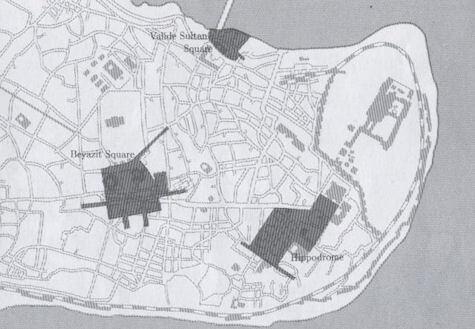
Another problem of the city, according to Von Moltke, was the lack of an established “square culture.” In line with this, suitable areas with monuments like mosques would be picked out and their surroundings would be demolished, clearing space to be made into a wide square, mirroring examples in Europe. Von Moltke reasoned that these demolitions would also benefit the city as fires spread easily due to adjacent wooden constructions that would be prevented by switching to ferro concrete-based buildings.
Von Moltke also envisioned both sides of the Golden Horn being cleared. Wooden piers were to be replaced by stone piers 15 meters wide; three meter sidewalks were to be built on either side, while trees would be planted along the road.
Von Moltke’s hoped to help create a modern and organized capital for the Ottoman Empire, which had recently started undergoing a Westernization process through the Tanzimat reforms. But his ideas were never realized and his projects were brought to a halt before they ever started.
2) RECONSTRUCTION ATTEMPTS AFTER GREAT FIRE OF 1865
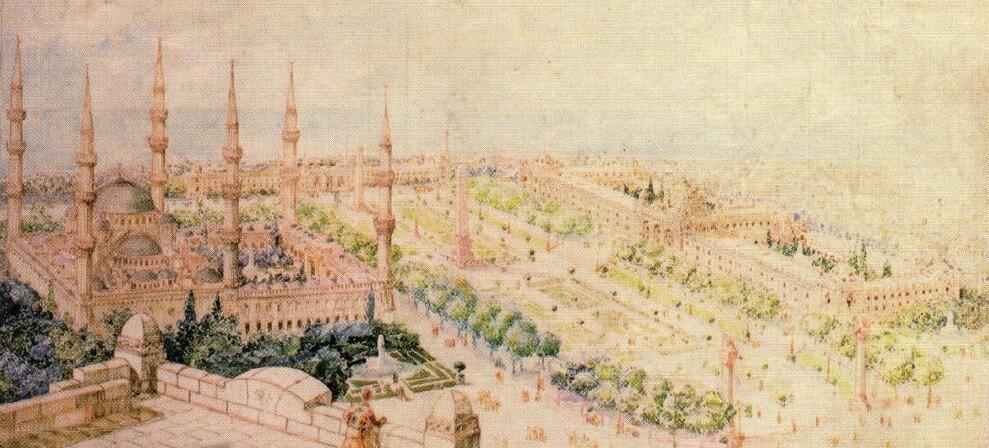
After Von Moltke’s aborted projects, there were no new attempts at the planning of Istanbul for many years. However, the Büyük Hocapaşa Fire, which destroyed two thirds of the city in 1865, caused the issue of city planning to be brought up once more. Sultan Abdülaziz and the grand vizier of the time, Keçecizade Fuat Pasha, saw this fire as an opportunity to reconstruct the city. For this they invited Baron Haussmann, who had previously demolished many parts of Paris, to reconstruct it. However, when Haussmann boldly suggested a wide boulevard starting from the Hagia Sophia - demolishing structures along the way such as the Grand Bazaar and the Nuruosmaniye Mosque - the project ended before it could even start.
Sultan Abdülhamid II subsequently started pondering the redevelopment of Istanbul and commissioned the Ottoman ambassador in Paris, Salih Münir Pasha, for the job.

After directions from the Sultan, Salih Münir Pasha returned to Paris and met with the Paris Governor Celot about the Sultan’s wishes. Joseph Antione Bouvard, the head architect of the Paris Municipality who had also constructed the World Exhibition in 1900, was then recommended to the Pasha and works began. In the Pasha’s words, Bouvard was “a kind and benevolent friend to the Turks. He had travelled and became very familiar with Istanbul.”
At first, Bouvard was not going to even come to Istanbul but was going to map out a structural plan according to the photographs sent to him, assemble a team, and travel to Istanbul himself once construction began. In the project he designed, Bouvard focused mainly on organizing the squares with the idea of Istanbul’s image and making it resemble other European capitals. He particularly focused on the Beyazıt, Sultanahmet, the Galata Bridge and the New Mosque areas.
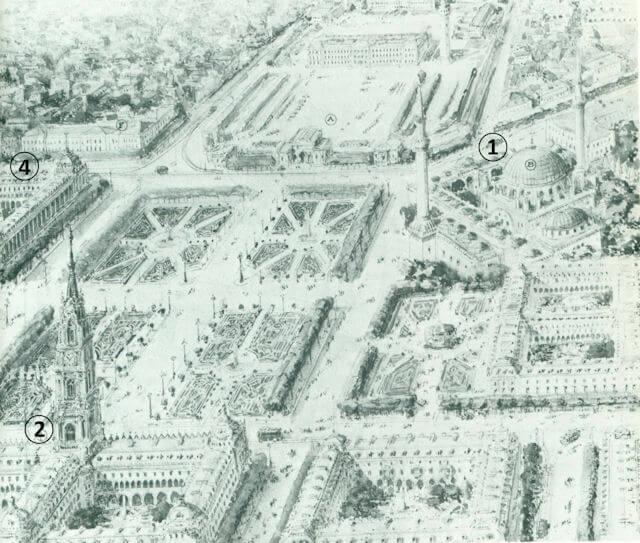
According to Bouvard’s project, Beyazıt was to be the main center of the city and a town hall was to be built there with a tall and ostentatious tower overshadowing the minarets of the Beyazıt Mosque. The Sultan Bayezid Madrasah was to be torn down and twin buildings with courtyards were to be built in its place. One of these buildings was going to be designed as the Industrial and Agricultural Museum, while the other was to be a National Library. Also, another set of demolitions was to take place to clear an area to construct French gardens.
A second square that Bouvard designed a plan for was Sultanahmet. According to the project, the square was to be dug up, connecting the original Byzantine floor to the street with steps. The square was planned to be made into a park, with French gardens around the remaining preserved columns of the Hippodrome. Two columns were to be constructed on either side of the main entrance to the square, creating a monumental entrance. To expand and regulate Sultanahmet Square, historic buildings within the Blue Mosque complex were to be demolished. The historic Ibrahim Pasha Palace, used today as the Museum of Islamic Arts, was to be demolished and a magnificent Police Directorate was to be built in its place.
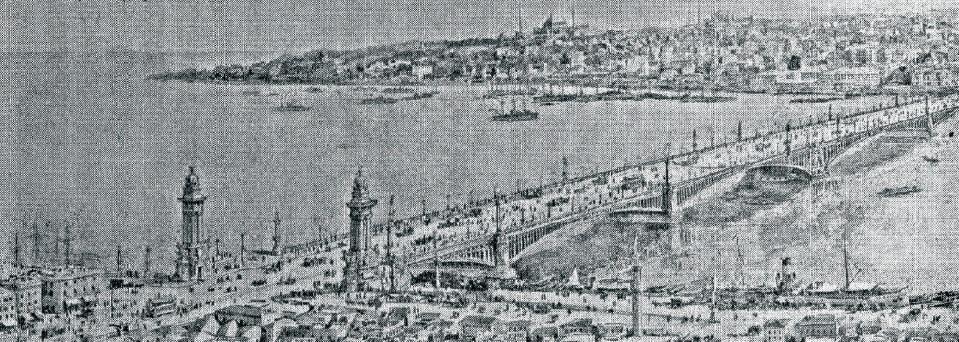
The unfulfilled Galata Bridge project
Despite the great disruption foreseen by these plans, Sultan Abdülhamid II greeted Bouvard’s vision with admiration, sharing the plans with ambassadors and the pashas around him.
The Sultan, demanding that the constructions get started right away and the constructed be equipped with electricity and gas, sent Salih Münir Pasha back to Paris to make the arrangements. Though Bouvard had worked for the Ottoman Empire and was to receive his salary from them, France paid all the expenses for the sketches and gave them to the Sultan as a gift. However, after realizing how expensive Bouvard’s projects were going to be, and with loan sharks in Istanbul keen to make a profit, Abdülhamid II eventually put the project on hold.
4) ARNODIN FOCUSES ON TRANSPORTATION
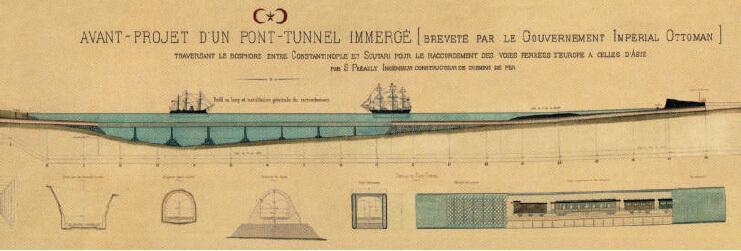
Sultan Abdulhamid’s underwater tunnel project connecting Istanbul’s two sides
Arnodin envisioned expanding the city by connecting the two continents with two bridges - one between Üsküdar and Sarayburnu, the other between Kandilli and Rumelihisarı - as well as developing Istanbul’s connections to cities elsewhere. Through the first bridge, the railway coming into Haydarpaşa would have been expanded to Üsküdar, establishing a link between Istanbul and Edirne. Arnodin’s second bridge was planned between Kandilli and Rumelihisarı; it was magnificent but remote from Ottoman and Istanbul architectural traditions - carrying traces of Umayyad architecture with mosques and monumental minarets on the abutments. Arnodin planned to name the bridge “Hamidiye” in honor of Sultan Abdulhamid II, but his orientalist fantasy was ultimately never realized.
Aside from these projects, many local and foreign architects and engineers prepared projects to alter Istanbul’s texture, social life, transportation and overall cityscape. Some were brought to life, but most remained unfulfilled. There are constantly new plans being made for Istanbul, a chaotic cityscape where life is constantly in flux. Perhaps some of today’s projects will never be realized - but it is impossible not to look back and wonder, “What if...”
(Translated and edited at the Hürriyet Daily News by Alkım Kutlu)
















